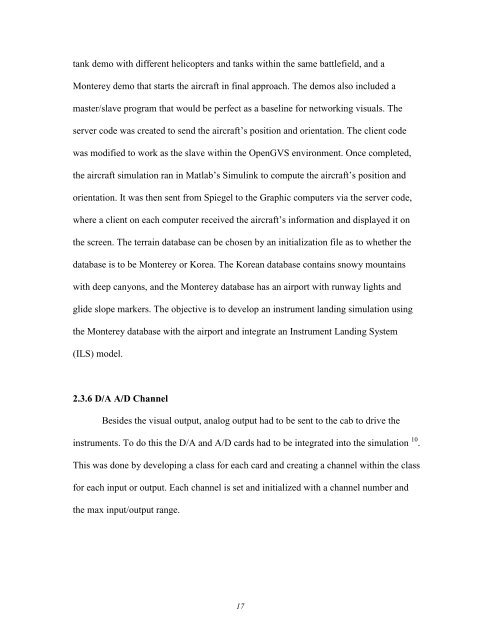Developement Of An Instrument Landing Simulation ... - Cal Poly
Developement Of An Instrument Landing Simulation ... - Cal Poly
Developement Of An Instrument Landing Simulation ... - Cal Poly
You also want an ePaper? Increase the reach of your titles
YUMPU automatically turns print PDFs into web optimized ePapers that Google loves.
tank demo with different helicopters and tanks within the same battlefield, and aMonterey demo that starts the aircraft in final approach. The demos also included amaster/slave program that would be perfect as a baseline for networking visuals. Theserver code was created to send the aircraft’s position and orientation. The client codewas modified to work as the slave within the OpenGVS environment. Once completed,the aircraft simulation ran in Matlab’s Simulink to compute the aircraft’s position andorientation. It was then sent from Spiegel to the Graphic computers via the server code,where a client on each computer received the aircraft’s information and displayed it onthe screen. The terrain database can be chosen by an initialization file as to whether thedatabase is to be Monterey or Korea. The Korean database contains snowy mountainswith deep canyons, and the Monterey database has an airport with runway lights andglide slope markers. The objective is to develop an instrument landing simulation usingthe Monterey database with the airport and integrate an <strong>Instrument</strong> <strong>Landing</strong> System(ILS) model.2.3.6 D/A A/D ChannelBesides the visual output, analog output had to be sent to the cab to drive theinstruments. To do this the D/A and A/D cards had to be integrated into the simulation 10 .This was done by developing a class for each card and creating a channel within the classfor each input or output. Each channel is set and initialized with a channel number andthe max input/output range.17













